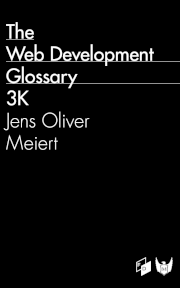Principles of Art, Design, and Decoration
Published on May 12, 2007 (↻ August 14, 2022), filed under Art and Design (RSS feed for all categories).
This post is outdated.
Much thinking about design has led me to the conclusion that defining the terms art, design, and decoration can be pretty simple. Outlining their principles, at least. Simpler than I thought in school (“what is art?”), and also simpler than I thought in earlier years.
- Art:
- Art hides. Art has a meaning, and it hides it, on purpose. Art delivers a message, and that message is hidden, on purpose. It is an art to create art. Art is unusable, by definition.
- Design:
- Design reveals. Design reveals meaning, design reveals function, design reveals a message. Bad design does the opposite: It obscures, it hides. The reason why that almost never makes bad design art is that the subject is supposed to be revealed.
- Decoration:
- Anything else that doesn’t have meaning is decoration, at most. Ask an artist what they want to achieve with their art piece—if they can’t tell (well, maybe they won’t tell), they’re a decorator, not an artist. Ask a designer why their design works—if they can’t tell, they’re probably a (lucky) decorator, not a designer. Decoration is sometimes appealing, but it doesn’t transport anything.
These definitions are simplified, sure, so they’re rather principles or attributes of art, design, and decoration. They rely on other definitions, like “meaning.” They also ignore certain factors like audience, context, and emotion. However, they seem to hold true often enough to be considered principles. I smell some confirmation bias, but that has been my observation.
What are your thoughts and experiences?
About Me

I’m Jens (long: Jens Oliver Meiert), and I’m a frontend engineering leader and tech author/publisher. I’ve worked as a technical lead for companies like Google and as an engineering manager for companies like Miro, I’m close to W3C and WHATWG, and I write and review books for O’Reilly and Frontend Dogma.
I love trying things, not only in web development (and engineering management), but also in other areas like philosophy. Here on meiert.com I share some of my views and experiences.
If you’d like to do me a favor, interpret charitably (I speak three languages, and they do collide), yet be critical and give feedback for me to fix issues, learn, and improve. Thank you!
Comments (Closed)
-
On May 14, 2007, 17:06 CEST, Stephan Riess said:
Design aims to provide a solution to a problem.
Decorating aims to cover up the problem. -
On May 14, 2007, 17:09 CEST, Jens Oliver Meiert said:
Did Daniel Schutzsmith inspire you? 😊
-
On June 27, 2007, 18:23 CEST, Jens Oliver Meiert said:
Don’t hesitate to comment directly… I may quote very interesting feedback from a reader from Washington:
But I would point out that what she’s describing isn’t so much the principles of three separate “disciplines,” but rather that there is a kind of triangular structure. On the vertical axis, you have “meaning”; horizontally, you have “reveal-occlude.” Thus, decoration is at the bottom, art is meaning+occlusion, and design is meaning+revelation.
The entire post’s worth reading, and I might reply in more detail later.
(Ah, I’m male, by the way.)
-
On December 27, 2007, 17:39 CET, passerby said:
“Art hides. Art has a meaning, and it hides it, on purpose. Art delivers a message, and that message is hidden, on purpose. It is an art to create art. Art is unusable, by definition.”
Really?
I wouldn’t be so sure about it. What we call art today was simply what you defined as design.
Many artists didn’t want to hide anything at all, they wanted to convey messages on behalf of their patrons;
they were paid to do so.
By saying that art hides and is unusable, you are fostering a romantic view of art.
You are saying Gauguin is art, and Caravaggio is not. -
On December 28, 2007, 13:17 CET, Jens Oliver Meiert said:
passerby, thank you.
By saying that art hides and is unusable, you are fostering a romantic view of art.
That is not intended, but I really need to think about that again in terms of how art cannot use “hiding” as an ”excuse”
[…].You are saying Gauguin is art, and Caravaggio is not.
To be honest, I don’t know many pieces of Caravaggio. Still, I might claim that some masters are “master decorators” rather than ”master artists”.
I need to add that creating appealing, beautiful, high-quality decoration is a remarkable discipline, one that must not be devalued by our current understanding of “decoration.” Good decoration is as rare as good design and good art.
As another side note, well, there’s a follow-up post: Qualities of Design: It Works and It’s Durable.
-
On January 18, 2009, 17:46 CET, Rose said:
Hello! This is not a very affective website, there is no color and it is supose to be for ART. Jens Meiert, I hope you get this and make some changes. I almost forgot…
I will be coming over for tea next weekend. (Yes I do know where you live.)
Thank You for leting people write comments. Again make changes or I will!
See ya!!
-? -
On January 18, 2009, 19:18 CET, Jens Oliver Meiert said:
…?
-
On January 18, 2011, 18:13 CET, Jens Oliver Meiert said:
More of an internal note that I’m not sure to be of broader interest:
Design is defined as “the use of higher thought and systematic process to achieve objectives.” It has nothing to do with graphics or frills. It has everything to do with being more effective and successful.
Read More
Maybe of interest to you, too:
- Next: Me on Czech TV
- Previous: 10 Steps to Create a High-Quality Website
- More under Art and Design
- More from 2007
- Most popular posts
Looking for a way to comment? Comments have been disabled, unfortunately.

Get a good look at web development? Try WebGlossary.info—and The Web Development Glossary 3K (2023). With explanations and definitions for thousands of terms of web development, web design, and related fields, building on Wikipedia as well as MDN Web Docs. Available at Apple Books, Kobo, Google Play Books, and Leanpub.
